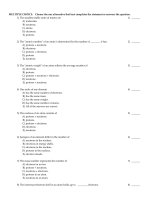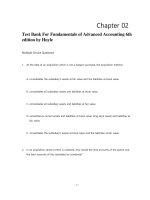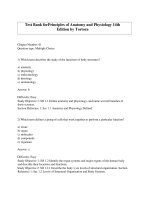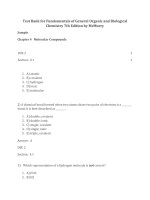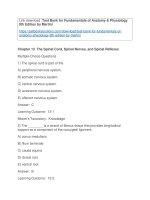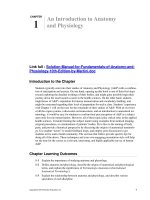Test bank for fundamentals of anatomy and physiology 11e c09 Joints
Bạn đang xem bản rút gọn của tài liệu. Xem và tải ngay bản đầy đủ của tài liệu tại đây (490.62 KB, 30 trang )
Chapterȱ9
Joints
Multiple Choice Questions
1) Jointsȱcanȱbeȱclassifiedȱstructurallyȱas
A) bony.
B) fibrous.
C) cartilaginous.
D) synovial.
E) Allȱofȱtheȱanswersȱareȱcorrect.
Answer: E
LearningȱOutcome: 9-1
BloomȇsȱTaxonomy: Remembering
2) Theȱsynarthrosisȱthatȱbindsȱtheȱteethȱtoȱtheȱbonyȱsocketsȱisȱa
A) suture.
B) gomphosis.
C) synchondrosis.
D) synotosis.
E) syndesmosis.
Answer: B
LearningȱOutcome: 9-1
BloomȇsȱTaxonomy: Remembering
3) Anȱimmovableȱjointȱisȱa(n)
A) synarthrosis.
B) diarthrosis.
C) amphiarthrosis.
D) syndesmosis.
E) symphysis.
Answer: A
LearningȱOutcome: 9-1
BloomȇsȱTaxonomy: Remembering
4) Aȱsynovialȱjointȱisȱanȱexampleȱofȱa(n)
A) synarthrosis.
B) amphiarthrosis.
C) diarthrosis.
D) symphysis.
E) syndesmosis.
Answer: C
LearningȱOutcome: 9-1
BloomȇsȱTaxonomy: Remembering
Copyrightȱ©ȱ2018ȱPearsonȱEducation,ȱInc.
Chapterȱ9ȱȱJointsȱȱȱ265
5) Aȱligamentousȱconnectionȱsuchȱasȱanȱantebrachialȱinterosseousȱmembraneȱisȱcalledȱa
A) syndesmosis.
B) symphysis.
C) synchondrosis.
D) synostosis.
E) gomphosis.
Answer: A
LearningȱOutcome: 9-1
BloomȇsȱTaxonomy: Remembering
6) Aȱslightlyȱmovableȱjointȱisȱa(n)
A) synarthrosis.
B) diarthrosis.
C) amphiarthrosis.
D) gomphosis.
E) synostosis.
Answer: C
LearningȱOutcome: 9-1
BloomȇsȱTaxonomy: Remembering
7) Aȱsutureȱisȱanȱexampleȱofȱa(n)
A) synarthrosis.
B) syndesmosis.
C) symphysis.
D) diarthrosis.
E) amphiarthrosis.
Answer: A
LearningȱOutcome: 9-1
BloomȇsȱTaxonomy: Remembering
8) Anȱepiphysealȱlineȱisȱanȱexampleȱofȱa
A) gomphosis.
B) synchondrosis.
C) synostosis.
D) symphysis.
E) syndesmosis.
Answer: C
LearningȱOutcome: 9-1
BloomȇsȱTaxonomy: Remembering
9) Denseȱfibrousȱconnectiveȱtissueȱisȱtoȱaȱsutureȱasȱaȱperiodontalȱligamentȱisȱtoȱa(n)
A) amphiarthrosis.
B) syndesmosis.
C) synostosis.
D) synchondrosis.
E) gomphosis.
Answer: E
LearningȱOutcome: 9-1
BloomȇsȱTaxonomy: Understanding
Copyrightȱ©ȱ2018ȱPearsonȱEducation,ȱInc.
266ȱȱȱTestȱBankȱforȱFundamentalsȱofȱAnatomyȱ&ȱPhysiology,ȱ11e
10) Anȱexampleȱofȱaȱsynchondrosisȱisȱtheȱarticulationȱofȱthe
A) ribsȱwithȱtheȱsternum.
B) radiusȱandȱtheȱulna.
C) femurȱwithȱtheȱacetabulum.
D) atlasȱandȱtheȱaxis.
E) navicularȱboneȱwithȱtheȱcuniformȱbones.
Answer: A
LearningȱOutcome: 9-1
BloomȇsȱTaxonomy: Remembering
11) Aȱfreelyȱmovableȱjointȱisȱa(n)
A) synarthrosis.
B) diarthrosis.
C) amphiarthrosis.
D) syndesmosis.
E) symphysis.
Answer: B
LearningȱOutcome: 9-1
BloomȇsȱTaxonomy: Remembering
12) Theȱintervertebralȱdiscȱjointȱisȱcalledȱa
A) synarthrosis.
B) glideȱjoint.
C) condylarȱjoint.
D) synchondrosis.
E) symphysis.
Answer: E
LearningȱOutcome: 9-1
BloomȇsȱTaxonomy: Remembering
13) Whichȱofȱtheȱfollowingȱisȱoneȱofȱtheȱfourȱmajorȱtypesȱofȱsynarthroticȱjoints?
A) suture
B) gomphosis
C) synchondrosis
D) synostosis
E) Allȱofȱtheȱanswersȱareȱcorrect.
Answer: E
LearningȱOutcome: 9-1
BloomȇsȱTaxonomy: Remembering
14) Syndesmosisȱisȱtoȱligamentȱasȱsymphysisȱisȱto
A) fibrousȱcartilage.
B) denseȱregularȱconnectiveȱtissue.
C) periodontalȱligament.
D) rigidȱcartilaginousȱbridge.
E) completelyȱfused.
Answer: A
LearningȱOutcome: 9-1
BloomȇsȱTaxonomy: Understanding
Copyrightȱ©ȱ2018ȱPearsonȱEducation,ȱInc.
Chapterȱ9ȱȱJointsȱȱȱ267
15) Structurally,ȱtheȱpubicȱsymphysisȱisȱclassifiedȱasȱaȱ________ȱarticulation.
A) cartilaginous
B) bony
C) synovial
D) fibrous
E) diarthrotic
Answer: A
LearningȱOutcome: 9-1
BloomȇsȱTaxonomy: Remembering
16) Identifyȱtheȱincorrectȱpair.
A) synarthrosis;ȱimmovableȱjoint
B) amphiarthrosis;ȱslightlyȱmovableȱjoint
C) chondrosis;ȱfreelyȱmovingȱjoint
D) gomphosis;ȱarticulationȱbetweenȱtoothȱandȱbone
E) Theyȱareȱallȱcorrect;ȱthereȱisȱnoȱincorrectȱpair.
Answer: C
LearningȱOutcome: 9-1
BloomȇsȱTaxonomy: Understanding
17) Whichȱofȱtheȱfollowingȱoccursȱwhenȱtheȱarticularȱcartilageȱisȱdamaged?
A) Theȱmatrixȱbeginsȱtoȱbreakȱdown.
B) Theȱexposedȱsurfaceȱappearsȱrough.
C) Frictionȱinȱtheȱjointȱincreases.
D) Normalȱsynovialȱjointȱfunctionȱisȱunableȱtoȱcontinue.
E) Allȱofȱtheȱanswersȱareȱcorrect.
Answer: E
LearningȱOutcome: 9-2
BloomȇsȱTaxonomy: Remembering
18) Whichȱofȱtheȱfollowingȱisȱnotȱaȱfunctionȱofȱsynovialȱfluid?
A) shockȱabsorption
B) increasesȱosmoticȱpressureȱwithinȱjoint
C) lubrication
D) providesȱnutrients
E) protectsȱarticularȱcartilages
Answer: B
LearningȱOutcome: 9-2
BloomȇsȱTaxonomy: Understanding
19) Bursaeȱareȱfoundȱinȱallȱofȱtheȱfollowingȱareasȱexcept
A) tendonȱsheaths.
B) beneathȱtheȱskinȱcoveringȱaȱbone.
C) withinȱconnectiveȱtissueȱexposedȱtoȱfrictionȱorȱpressure.
D) aroundȱbloodȱvessels.
E) aroundȱmanyȱsynovialȱjoints.
Answer: D
LearningȱOutcome: 9-2
BloomȇsȱTaxonomy: Remembering
Copyrightȱ©ȱ2018ȱPearsonȱEducation,ȱInc.
268ȱȱȱTestȱBankȱforȱFundamentalsȱofȱAnatomyȱ&ȱPhysiology,ȱ11e
20) Whichȱofȱtheȱfollowingȱisȱnotȱaȱpropertyȱofȱarticularȱcartilage?
A) coveredȱbyȱperichondrium
B) lubricatedȱbyȱsynovialȱfluid
C) enclosedȱbyȱanȱarticularȱcapsule
D) similarȱtoȱhyalineȱcartilage
E) smooth,ȱlow-frictionȱsurface
Answer: A
LearningȱOutcome: 9-2
BloomȇsȱTaxonomy: Remembering
21) Theȱsurfaceȱofȱarticularȱcartilageȱis
A) slick.
B) flat.
C) smooth.
D) rough.
E) bothȱslickȱandȱsmooth.
Answer: E
LearningȱOutcome: 9-2
BloomȇsȱTaxonomy: Remembering
22) Whichȱofȱtheȱfollowingȱisȱnotȱconsideredȱanȱaccessoryȱsynovialȱstructure?
A) fatȱpads
B) menisci
C) tendons
D) bursae
E) synovialȱmembrane
Answer: E
LearningȱOutcome: 9-2
BloomȇsȱTaxonomy: Remembering
23) Mikeȱfallsȱoffȱhisȱskateboardȱandȱsprainsȱhisȱankle.ȱWhichȱofȱtheȱfollowingȱmostȱlikelyȱoccurs
withȱthisȱtypeȱofȱaccident?
A) Aȱbursaȱisȱdamagedȱandȱleaksȱsynovialȱfluid.
B) Aȱligamentȱisȱstretchedȱandȱcollagenȱfibersȱinȱtheȱligamentȱareȱdamaged.
C) Articulatingȱbonesȱareȱforcedȱoutȱofȱpositionȱandȱligamentsȱareȱtorn.
D) Dislocationȱofȱtheȱankleȱoccurs.
E) Theȱtibiaȱisȱbrokenȱandȱmustȱbeȱsetȱinȱaȱcast.
Answer: B
LearningȱOutcome: 9-2
BloomȇsȱTaxonomy: Applying
24) Whichȱofȱtheȱfollowingȱisȱnotȱaȱpropertyȱofȱsynovialȱjoints?
A) freelyȱmovable
B) linedȱbyȱaȱsecretoryȱepithelium
C) coveredȱbyȱaȱserousȱmembrane
D) containȱsynovialȱfluid
E) coveredȱbyȱaȱcapsule
Answer: C
LearningȱOutcome: 9-2
BloomȇsȱTaxonomy: Understanding
Copyrightȱ©ȱ2018ȱPearsonȱEducation,ȱInc.
Chapterȱ9ȱȱJointsȱȱȱ269
Figureȱ9-1ȱAȱSimplifiedȱSectionalȱViewȱofȱtheȱKneeȱJoint
UseȱFigureȱ9-1ȱtoȱanswerȱtheȱfollowingȱquestions:
25) Whichȱstructureȱactsȱasȱaȱcushionȱandȱconsistsȱofȱfibrousȱcartilage?
A) 1
B) 2
C) 3
D) 4
E) 5
Answer: D
LearningȱOutcome: 9-2
BloomȇsȱTaxonomy: Applying
26) IdentifyȱtheȱstructureȱatȱlabelȱȈ1.Ȉ
A) meniscus
B) bursa
C) articularȱcartilage
D) synovialȱmembrane
E) jointȱcavity
Answer: B
LearningȱOutcome: 9-2
BloomȇsȱTaxonomy: Applying
Copyrightȱ©ȱ2018ȱPearsonȱEducation,ȱInc.
270ȱȱȱTestȱBankȱforȱFundamentalsȱofȱAnatomyȱ&ȱPhysiology,ȱ11e
27) IdentifyȱtheȱstructureȱlabeledȱȈ2.Ȉ
A) serousȱmembrane
B) synovialȱmembrane
C) jointȱcapsule
D) periosteum
E) intracapsularȱligament
Answer: B
LearningȱOutcome: 9-2
BloomȇsȱTaxonomy: Applying
28) WhatȱtypeȱofȱtissueȱoccursȱatȱtheȱstructureȱlabeledȱȈ3Ȉ?
A) fibrocartilage
B) synovialȱmembrane
C) articularȱcartilage
D) boneȱtissue
E) denseȱconnectiveȱtissue
Answer: C
LearningȱOutcome: 9-2
BloomȇsȱTaxonomy: Applying
29) IdentifyȱtheȱstructureȱlabeledȱȈ5.Ȉ
A) serousȱmembrane
B) synovialȱmembrane
C) jointȱcapsule
D) periosteum
E) intracapsularȱligament
Answer: E
LearningȱOutcome: 9-2
BloomȇsȱTaxonomy: Applying
30) Usuallyȱfoundȱoutsideȱtheȱcapsule,ȱ________ȱprotectȱtheȱarticularȱcartilagesȱandȱactȱasȱpacking
materialȱforȱtheȱjoint.
A) ligaments
B) tendons
C) bursae
D) menisci
E) fatȱpads
Answer: E
LearningȱOutcome: 9-2
BloomȇsȱTaxonomy: Remembering
Copyrightȱ©ȱ2018ȱPearsonȱEducation,ȱInc.
Chapterȱ9ȱȱJointsȱȱȱ271
31) Smallȱpocketsȱofȱsynovialȱfluidȱthatȱreduceȱfrictionȱandȱactȱasȱaȱshockȱabsorberȱwhere
ligamentsȱandȱtendonsȱrubȱagainstȱotherȱtissuesȱareȱcalled
A) fatȱpads.
B) menisci.
C) bursae.
D) lacunae.
E) fasciae.
Answer: C
LearningȱOutcome: 9-2
BloomȇsȱTaxonomy: Remembering
32) ________ȱsubdivideȱsynovialȱcavities,ȱchannelȱtheȱflowȱofȱsynovialȱfluid,ȱandȱallowȱfor
variationsȱinȱtheȱshapesȱofȱtheȱarticularȱsurfaces.
A) Fatȱpads
B) Menisci
C) Bursae
D) Lacunae
E) Fasciae
Answer: B
LearningȱOutcome: 9-2
BloomȇsȱTaxonomy: Remembering
33) Aȱ________ȱoccursȱwhenȱarticulatingȱsurfacesȱareȱforcedȱoutȱofȱposition.
A) fracture
B) bunion
C) bursitis
D) dislocation
E) sprain
Answer: D
LearningȱOutcome: 9-2
BloomȇsȱTaxonomy: Understanding
34) Theȱthreeȱfunctionsȱofȱsynovialȱfluidȱareȱnutrientȱdistribution,ȱshockȱabsorption,ȱand
A) stabilization.
B) lubrication.
C) padding.
D) strengthening.
E) enzymeȱsecretion.
Answer: B
LearningȱOutcome: 9-2
BloomȇsȱTaxonomy: Remembering
Copyrightȱ©ȱ2018ȱPearsonȱEducation,ȱInc.
272ȱȱȱTestȱBankȱforȱFundamentalsȱofȱAnatomyȱ&ȱPhysiology,ȱ11e
35) Aȱ________ȱisȱaȱtenderȱnoduleȱformedȱaroundȱbursaeȱoverȱtheȱbaseȱofȱtheȱgreatȱtoe.
A) spur
B) blister
C) callus
D) bunion
E) pimple
Answer: D
LearningȱOutcome: 9-2
BloomȇsȱTaxonomy: Remembering
36) Aȱcollagenousȱtypeȱofȱconnectiveȱtissueȱthatȱreinforcesȱtheȱsynovialȱjointȱandȱisȱfoundȱoutside
theȱjointȱcapsuleȱisȱcalledȱthe
A) extracapsularȱtendon.
B) intracapsularȱligament.
C) extracapsularȱligament.
D) intracapsularȱtendon.
E) meniscus.
Answer: C
LearningȱOutcome: 9-2
BloomȇsȱTaxonomy: Remembering
37) Whichȱoneȱofȱtheȱfollowingȱisȱnot aȱstabilizingȱfactorȱofȱsynovialȱjoints?
A) skeletalȱmusclesȱaroundȱtheȱjoint
B) theȱpresenceȱofȱaȱmeniscus
C) collagenȱfibersȱofȱtheȱjointȱcapsule
D) fatȱpadsȱaroundȱtheȱjoint
E) theȱsynovialȱmembrane
Answer: E
LearningȱOutcome: 9-2
BloomȇsȱTaxonomy: Understanding
38) Theȱjointȱbetweenȱtheȱforearmȱbonesȱandȱtheȱwristȱisȱaȱ________ȱjoint.
A) saddle
B) glide
C) hinge
D) condylar
E) pivot
Answer: D
LearningȱOutcome: 9-3
BloomȇsȱTaxonomy: Understanding
39) Ankleȱextensionȱisȱalsoȱcalled
A) dorsiflexion.
B) inversion.
C) eversion.
D) plantarȱflexion.
E) protraction.
Answer: D
LearningȱOutcome: 9-3
BloomȇsȱTaxonomy: Remembering
Copyrightȱ©ȱ2018ȱPearsonȱEducation,ȱInc.
Chapterȱ9ȱȱJointsȱȱȱ273
40) Pronationȱisȱdefinedȱas
A) aȱrollingȱofȱtheȱdistalȱepiphysisȱofȱtheȱradiusȱoverȱtheȱulna.
B) aȱtwistingȱofȱtheȱulnaȱmedially.
C) twistingȱtheȱforearmȱsoȱthatȱtheȱpalmsȱfaceȱanteriorly.
D) theȱshorteningȱofȱtheȱangleȱbetweenȱtheȱradiusȱandȱtheȱhumerus.
E) movementȱofȱtheȱmandibleȱanteriorly,ȱasȱseenȱwhenȱbitingȱtheȱupperȱlip.
Answer: A
LearningȱOutcome: 9-3
BloomȇsȱTaxonomy: Remembering
41) Aȱmovementȱawayȱfromȱtheȱmidlineȱofȱtheȱbodyȱisȱcalled
A) inversion.
B) abduction.
C) adduction.
D) flexion.
E) extension.
Answer: B
LearningȱOutcome: 9-3
BloomȇsȱTaxonomy: Remembering
42) Toȱpinchȱwithȱaȱthumbȱandȱfingerȱinvolvesȱaȱmovementȱcalled
A) rotation.
B) opposition.
C) circumduction.
D) eversion.
E) retraction.
Answer: B
LearningȱOutcome: 9-3
BloomȇsȱTaxonomy: Remembering
43) Aȱcommonȱinjuryȱtoȱtheȱankleȱoccursȱbyȱexcessiveȱturningȱofȱtheȱsoleȱinward,ȱcalled
A) eversion.
B) protraction.
C) dorsiflexion.
D) plantarȱflexion.
E) inversion.
Answer: E
LearningȱOutcome: 9-3
BloomȇsȱTaxonomy: Remembering
44) Theȱankleȱjointȱisȱanȱexampleȱofȱa(n)ȱ________ȱjoint.
A) condylar
B) saddle
C) hinge
D) ball-and-socket
E) gliding
Answer: C
LearningȱOutcome: 9-3
BloomȇsȱTaxonomy: Understanding
Copyrightȱ©ȱ2018ȱPearsonȱEducation,ȱInc.
274ȱȱȱTestȱBankȱforȱFundamentalsȱofȱAnatomyȱ&ȱPhysiology,ȱ11e
45) Whichȱofȱtheȱfollowingȱmovementsȱisȱaȱgoodȱexampleȱofȱflexion?
A) openingȱtheȱmouth
B) turningȱtheȱhandȱpalmȱupward
C) extremeȱbendingȱofȱtheȱheadȱbackwards
D) bendingȱtheȱelbow
E) spreadingȱtheȱfingers
Answer: D
LearningȱOutcome: 9-3
BloomȇsȱTaxonomy: Understanding
46) Aȱtwistingȱmotionȱofȱtheȱfootȱthatȱturnsȱtheȱsoleȱofȱtheȱfootȱoutwardȱisȱknownȱas
A) inversion.
B) plantarȱflexion.
C) eversion.
D) dorsiflexion.
E) pronation.
Answer: C
LearningȱOutcome: 9-3
BloomȇsȱTaxonomy: Remembering
47) Theȱjointsȱthatȱconnectȱtheȱfourȱfingersȱwithȱtheȱmetacarpalȱbonesȱare
A) condylarȱjoints.
B) saddleȱjoints.
C) pivotȱjoints.
D) hingeȱjoints.
E) condyloidȱjoints.
Answer: A
LearningȱOutcome: 9-3
BloomȇsȱTaxonomy: Understanding
48) Theȱjointȱbetweenȱtheȱtrapeziumȱandȱmetacarpalȱboneȱofȱtheȱthumbȱisȱanȱexampleȱofȱa
________ȱjoint.
A) saddle
B) gliding
C) condylar
D) hinge
E) pivot
Answer: A
LearningȱOutcome: 9-3
BloomȇsȱTaxonomy: Understanding
49) Monaxialȱjointsȱareȱknownȱasȱ________ȱjoints.
A) saddle
B) gliding
C) ball-and-socket
D) condylar
E) hinge
Answer: E
LearningȱOutcome: 9-3
BloomȇsȱTaxonomy: Understanding
Copyrightȱ©ȱ2018ȱPearsonȱEducation,ȱInc.
Chapterȱ9ȱȱJointsȱȱȱ275
50) Whichȱtypeȱofȱjointȱisȱfoundȱbetweenȱtheȱcarpalȱbones?
A) saddle
B) gliding
C) hinge
D) ball-and-socket
E) pivot
Answer: B
LearningȱOutcome: 9-3
BloomȇsȱTaxonomy: Remembering
51) Whichȱofȱtheȱfollowingȱtypesȱofȱjointsȱisȱmonaxial,ȱbutȱcapableȱofȱonlyȱrotation?
A) saddle
B) gliding
C) hinge
D) ball-and-socket
E) pivot
Answer: E
LearningȱOutcome: 9-3
BloomȇsȱTaxonomy: Remembering
52) CurlingȱintoȱtheȱȈfetalȱpositionȈȱ________ȱtheȱintervertebralȱjoints.
A) hyperextends
B) flexes
C) abducts
D) extends
E) rotates
Answer: B
LearningȱOutcome: 9-3
BloomȇsȱTaxonomy: Applying
53) Theȱmovementsȱknownȱasȱdorsiflexionȱandȱplantarȱflexionȱinvolveȱmovingȱthe
A) hand.
B) arm.
C) foot.
D) leg.
E) hip.
Answer: C
LearningȱOutcome: 9-3
BloomȇsȱTaxonomy: Remembering
54) Theȱelbowȱjointȱisȱanȱexampleȱofȱa(n)ȱ________ȱjoint.
A) saddle
B) gliding
C) condylar
D) hinge
E) pivot
Answer: D
LearningȱOutcome: 9-3
BloomȇsȱTaxonomy: Remembering
Copyrightȱ©ȱ2018ȱPearsonȱEducation,ȱInc.
276ȱȱȱTestȱBankȱforȱFundamentalsȱofȱAnatomyȱ&ȱPhysiology,ȱ11e
55) Inȱaȱtriaxialȱarticulation,
A) movementȱcanȱoccurȱinȱallȱthreeȱaxes.
B) movementȱcanȱoccurȱinȱonlyȱtwoȱaxes.
C) movementȱcanȱoccurȱinȱonlyȱoneȱaxis.
D) onlyȱcircumductionȱisȱpossible.
E) noȱmovementȱisȱpossible.
Answer: A
LearningȱOutcome: 9-3
BloomȇsȱTaxonomy: Understanding
56) Anȱextensionȱpastȱtheȱanatomicalȱpositionȱisȱknownȱas
A) double-jointed.
B) extension.
C) flexion.
D) rotation.
E) hyperextension.
Answer: E
LearningȱOutcome: 9-3
BloomȇsȱTaxonomy: Remembering
57) Whichȱofȱtheȱfollowingȱjointsȱisȱanȱexampleȱofȱaȱball-and-socketȱjoint?
A) elbow
B) knee
C) ankle
D) wrist
E) shoulder
Answer: E
LearningȱOutcome: 9-3
BloomȇsȱTaxonomy: Remembering
58) Theȱjointsȱbetweenȱvertebraeȱareȱexamplesȱofȱ________ȱjoints.
A) saddle
B) pivot
C) condylar
D) hinge
E) gliding
Answer: E
LearningȱOutcome: 9-3
BloomȇsȱTaxonomy: Remembering
59) Whichȱfootȱmovementȱenablesȱtheȱballerinaȱtoȱstandȱonȱherȱtoes?
A) dorsiflexion
B) plantarȱflexion
C) inversion
D) rotation
E) eversion
Answer: B
LearningȱOutcome: 9-3
BloomȇsȱTaxonomy: Applying
Copyrightȱ©ȱ2018ȱPearsonȱEducation,ȱInc.
Chapterȱ9ȱȱJointsȱȱȱ277
60) Whichȱofȱtheȱfollowingȱmovementsȱisȱaȱgoodȱexampleȱofȱsupination?
A) openingȱtheȱmouth
B) turningȱtheȱhandȱpalmȱupward
C) extremeȱbendingȱofȱtheȱheadȱbackwards
D) movingȱtheȱhandȱtowardȱtheȱshoulder
E) spreadingȱtheȱfingers
Answer: B
LearningȱOutcome: 9-3
BloomȇsȱTaxonomy: Understanding
61) Liftingȱaȱstoneȱwithȱtheȱtipȱofȱfootȱis
A) circumduction.
B) eversion.
C) inversion.
D) plantarȱflexion.
E) dorsiflexion.
Answer: E
LearningȱOutcome: 9-3
BloomȇsȱTaxonomy: Understanding
62) Whichȱofȱtheȱfollowingȱmovementsȱisȱaȱgoodȱexampleȱofȱhyperextension?
A) openingȱtheȱmouth
B) turningȱtheȱhandȱpalmȱupward
C) extremeȱbendingȱofȱtheȱheadȱbackwards
D) movingȱtheȱhandȱtowardȱtheȱshoulder
E) spreadingȱtheȱfingers
Answer: C
LearningȱOutcome: 9-3
BloomȇsȱTaxonomy: Understanding
63) Whichȱofȱtheȱfollowingȱmovementsȱisȱaȱgoodȱexampleȱofȱabduction?
A) openingȱtheȱmouth
B) turningȱtheȱhandȱpalmȱupward
C) extremeȱbendingȱofȱtheȱheadȱbackwards
D) movingȱtheȱhandȱtowardȱtheȱshoulder
E) spreadingȱtheȱfingers
Answer: E
LearningȱOutcome: 9-3
BloomȇsȱTaxonomy: Understanding
64) Whichȱofȱtheȱfollowingȱmovementsȱisȱaȱgoodȱexampleȱofȱdepression?
A) openingȱtheȱmouth
B) turningȱtheȱhandȱpalmȱupward
C) extremeȱbendingȱofȱtheȱheadȱbackwards
D) movingȱtheȱhandȱtowardȱtheȱshoulder
E) spreadingȱtheȱfingers
Answer: A
LearningȱOutcome: 9-3
BloomȇsȱTaxonomy: Understanding
Copyrightȱ©ȱ2018ȱPearsonȱEducation,ȱInc.
278ȱȱȱTestȱBankȱforȱFundamentalsȱofȱAnatomyȱ&ȱPhysiology,ȱ11e
65) NoddingȱyourȱheadȱȈyesȈȱisȱanȱexampleȱof
A) lateralȱandȱmedialȱrotation.
B) circumduction.
C) flexionȱandȱextension.
D) pronationȱandȱsupination.
E) protractionȱandȱretraction.
Answer: C
LearningȱOutcome: 9-3
BloomȇsȱTaxonomy: Understanding
66) Whichȱofȱtheȱfollowingȱmovementsȱwouldȱyouȱassociateȱwithȱchewingȱfood?
A) elevation
B) abduction
C) flexion
D) pronation
E) circumduction
Answer: A
LearningȱOutcome: 9-3
BloomȇsȱTaxonomy: Understanding
Figureȱ9-2ȱBonesȱofȱtheȱWristȱandȱHand
Copyrightȱ©ȱ2018ȱPearsonȱEducation,ȱInc.
Chapterȱ9ȱȱJointsȱȱȱ279
UseȱFigureȱ9-2ȱtoȱanswerȱtheȱfollowingȱquestions:
67) IdentifyȱtheȱtypeȱofȱjointȱatȱlabelȱȈ1.Ȉ
A) hinge
B) condylar
C) gliding
D) saddle
E) pivot
Answer: B
LearningȱOutcome: 9-3
BloomȇsȱTaxonomy: Applying
68) IdentifyȱtheȱtypeȱofȱjointȱatȱlabelȱȈ2.Ȉ
A) hinge
B) condylar
C) gliding
D) saddle
E) pivot
Answer: C
LearningȱOutcome: 9-3
BloomȇsȱTaxonomy: Applying
69) IdentifyȱtheȱtypeȱofȱjointȱatȱlabelȱȈ3.Ȉ
A) hinge
B) gliding
C) condylar
D) saddle
E) pivot
Answer: D
LearningȱOutcome: 9-3
BloomȇsȱTaxonomy: Applying
70) IdentifyȱtheȱtypeȱofȱjointȱatȱlabelȱȈ4.Ȉ
A) hinge
B) gliding
C) condylar
D) saddle
E) pivot
Answer: C
LearningȱOutcome: 9-3
BloomȇsȱTaxonomy: Applying
Copyrightȱ©ȱ2018ȱPearsonȱEducation,ȱInc.
280ȱȱȱTestȱBankȱforȱFundamentalsȱofȱAnatomyȱ&ȱPhysiology,ȱ11e
71) IdentifyȱtheȱtypeȱofȱjointȱatȱlabelȱȈ5.Ȉ
A) hinge
B) condylar
C) gliding
D) saddle
E) pivot
Answer: A
LearningȱOutcome: 9-3
BloomȇsȱTaxonomy: Applying
72) Theȱmovementȱofȱrotatingȱaȱlimbȱtowardȱtheȱanteriorȱsurfaceȱofȱtheȱbodyȱisȱcalledȱ________
rotation.
A) frontal
B) external
C) lateral
D) outward
E) medial
Answer: E
LearningȱOutcome: 9-3
BloomȇsȱTaxonomy: Remembering
73) Theȱmovementȱofȱrotatingȱaȱlimbȱoutwardȱisȱcalledȱ________ȱrotation.
A) lateral
B) internal
C) medial
D) superficial
E) abductive
Answer: A
LearningȱOutcome: 9-3
BloomȇsȱTaxonomy: Remembering
74) Theȱatlantoaxialȱjointȱisȱanȱexampleȱofȱaȱ________ȱjoint.
A) ballȱandȱsocket
B) pivot
C) gliding
D) condyloid
E) saddle
Answer: B
LearningȱOutcome: 9-3
BloomȇsȱTaxonomy: Remembering
75) Theȱmovementȱofȱtheȱforearmȱwhileȱtwistingȱaȱdoorknobȱis
A) protractionȱandȱretraction.
B) abductionȱandȱadduction.
C) flexionȱandȱextension.
D) lateralȱrotationȱandȱmedialȱrotation.
E) supinationȱandȱpronation.
Answer: E
LearningȱOutcome: 9-3
BloomȇsȱTaxonomy: Understanding
Copyrightȱ©ȱ2018ȱPearsonȱEducation,ȱInc.
Chapterȱ9ȱȱJointsȱȱȱ281
76) Identifyȱtheȱincorrectȱpair.
A) glidingȱjoint;ȱsacroiliacȱjoint
B) pivotȱjoint;ȱhipȱjoint
C) hingeȱjoint;ȱankleȱjoint
D) condylarȱjoint;ȱradiocarpalȱjoint
E) saddleȱjoint;ȱfirstȱcarpometacarpalȱjoint
Answer: B
LearningȱOutcome: 9-3
BloomȇsȱTaxonomy: Understanding
77) Youȱ________ȱyourȱmandibleȱwhenȱyouȱgraspȱyourȱupperȱlipȱwithȱyourȱlowerȱteeth.
A) rotate
B) extend
C) pivot
D) protract
E) pronate
Answer: D
LearningȱOutcome: 9-3
BloomȇsȱTaxonomy: Understanding
78) Theȱmovementȱofȱaȱbodyȱpartȱupwardȱisȱcalled
A) extension.
B) protraction.
C) supination.
D) elevation.
E) abduction.
Answer: D
LearningȱOutcome: 9-3
BloomȇsȱTaxonomy: Remembering
79) Whichȱofȱtheȱfollowingȱtypesȱofȱmovementȱareȱnot permittedȱatȱaȱsynovialȱjoint?
A) eversion
B) flexion
C) retraction
D) gliding
E) Theyȱareȱallȱpermitted.
Answer: E
LearningȱOutcome: 9-3
BloomȇsȱTaxonomy: Remembering
80) Theȱmovementȱofȱaȱbodyȱpartȱdownwardȱisȱcalled
A) retraction.
B) pronation.
C) depression.
D) protraction.
E) eversion.
Answer: C
LearningȱOutcome: 9-3
BloomȇsȱTaxonomy: Remembering
Copyrightȱ©ȱ2018ȱPearsonȱEducation,ȱInc.
282ȱȱȱTestȱBankȱforȱFundamentalsȱofȱAnatomyȱ&ȱPhysiology,ȱ11e
81) ________ȱisȱaȱtypeȱofȱangularȱmovementȱthatȱincreasesȱtheȱangleȱbetweenȱarticulatingȱbones.
A) Adduction
B) Abduction
C) Flexion
D) Extension
E) Rotation
Answer: D
LearningȱOutcome: 9-3
BloomȇsȱTaxonomy: Remembering
82) ________ȱisȱaȱtypeȱofȱangularȱmovementȱthatȱdecreasesȱtheȱangleȱbetweenȱarticulatingȱbones.
A) Adduction
B) Abduction
C) Flexion
D) Extension
E) Rotation
Answer: C
LearningȱOutcome: 9-3
BloomȇsȱTaxonomy: Remembering
83) Whichȱofȱtheȱfollowingȱisȱnotȱaȱtypeȱofȱsynovialȱjoint?
A) gliding
B) hinge
C) pivot
D) symphysis
E) condylar
Answer: D
LearningȱOutcome: 9-3
BloomȇsȱTaxonomy: Remembering
84) Allȱofȱtheȱfollowingȱmovementsȱoccurȱatȱtheȱintervertebralȱjointsȱ except
A) flexion.
B) rotation.
C) dorsiflexion.
D) lateralȱflexion.
E) extension.
Answer: C
LearningȱOutcome: 9-4
BloomȇsȱTaxonomy: Understanding
85) Theȱgelatinousȱcoreȱofȱanȱintervertebralȱdiscȱisȱcalledȱthe
A) annulusȱfibrosus.
B) nucleusȱpulposus.
C) synovialȱfluid.
D) gelatinousȱpulposus.
E) gelatinousȱfibrosus.
Answer: B
LearningȱOutcome: 9-4
BloomȇsȱTaxonomy: Remembering
Copyrightȱ©ȱ2018ȱPearsonȱEducation,ȱInc.
Chapterȱ9ȱȱJointsȱȱȱ283
86) Theȱfibrocartilageȱouterȱlayerȱofȱtheȱintervertebralȱdiscȱisȱcalledȱthe
A) annulusȱfibrosus.
B) nucleusȱpulposus.
C) synovialȱfluid.
D) gelatinousȱpulposus.
E) gelatinousȱfibrosus.
Answer: A
LearningȱOutcome: 9-4
BloomȇsȱTaxonomy: Remembering
87) Theȱflavaȱligamentȱis
A) aȱpairedȱligamentȱthatȱconnectȱtheȱlaminaeȱofȱadjacentȱvertebrae.
B) aȱfibrousȱbandȱthatȱconnectsȱtheȱposteriorȱsurfacesȱofȱadjacentȱvertebralȱbodies.
C) aȱbandȱofȱfibrousȱtissueȱconnectingȱtheȱspinousȱprocessesȱofȱadjacentȱvertebrae.
D) aȱlongitudinalȱfibrousȱbandȱthatȱisȱattachedȱtoȱtheȱtipsȱofȱspinousȱprocessesȱfromȱC7ȱto
theȱsacrum.
E) aȱwideȱfibrousȱbandȱthatȱconnectȱtheȱanteriorȱsurfacesȱofȱtheȱadjacentȱvertebralȱbodies.
Answer: A
LearningȱOutcome: 9-4
BloomȇsȱTaxonomy: Remembering
88) Theȱsupraspinousȱligamentȱis
A) aȱpairedȱligamentȱthatȱconnectsȱtheȱlaminaeȱofȱadjacentȱvertebrae.
B) aȱfibrousȱbandȱthatȱconnectsȱtheȱposteriorȱsurfacesȱofȱadjacentȱvertebralȱbodies.
C) aȱbandȱofȱfibrousȱtissueȱconnectingȱtheȱspinousȱprocessesȱofȱadjacentȱvertebrae.
D) aȱlongitudinalȱfibrousȱbandȱthatȱisȱattachedȱtoȱtheȱtipsȱofȱspinousȱprocessesȱfromȱC7ȱto
theȱsacrum.
E) aȱwideȱfibrousȱbandȱthatȱconnectȱtheȱanteriorȱsurfacesȱofȱtheȱadjacentȱvertebralȱbodies.
Answer: D
LearningȱOutcome: 9-4
BloomȇsȱTaxonomy: Remembering
89) Theȱinterspinousȱligamentȱis
A) aȱpairedȱligamentȱthatȱconnectsȱtheȱlaminaeȱofȱadjacentȱvertebrae.
B) aȱfibrousȱbandȱthatȱconnectsȱtheȱposteriorȱsurfacesȱofȱadjacentȱvertebralȱbodies.
C) aȱbandȱofȱfibrousȱtissueȱconnectingȱtheȱspinousȱprocessesȱofȱadjacentȱvertebrae.
D) aȱlongitudinalȱfibrousȱbandȱthatȱisȱattachedȱtoȱtheȱtipsȱofȱspinousȱprocessesȱfromȱC7ȱto
theȱsacrum.
E) aȱwideȱfibrousȱbandȱthatȱconnectȱtheȱanteriorȱsurfacesȱofȱtheȱadjacentȱvertebralȱbodies.
Answer: C
LearningȱOutcome: 9-4
BloomȇsȱTaxonomy: Remembering
Copyrightȱ©ȱ2018ȱPearsonȱEducation,ȱInc.
284ȱȱȱTestȱBankȱforȱFundamentalsȱofȱAnatomyȱ&ȱPhysiology,ȱ11e
90) Theȱanteriorȱlongitudinalȱligamentȱis
A) aȱpairedȱligamentȱthatȱconnectsȱtheȱlaminaeȱofȱadjacentȱvertebrae.
B) aȱfibrousȱbandȱthatȱconnectsȱtheȱposteriorȱsurfacesȱofȱadjacentȱvertebralȱbodies.
C) aȱbandȱofȱfibrousȱtissueȱconnectingȱtheȱspinousȱprocessesȱofȱadjacentȱvertebrae.
D) aȱlongitudinalȱfibrousȱbandȱthatȱisȱattachedȱtoȱtheȱtipsȱofȱspinousȱprocessesȱfromȱC7ȱto
theȱsacrum.
E) aȱwideȱfibrousȱbandȱthatȱconnectȱtheȱanteriorȱsurfacesȱofȱtheȱadjacentȱvertebralȱbodies.
Answer: E
LearningȱOutcome: 9-4
BloomȇsȱTaxonomy: Remembering
91) Theȱposteriorȱlongitudinalȱligamentȱis
A) aȱpairedȱligamentȱthatȱconnectsȱtheȱlaminaeȱofȱadjacentȱvertebrae.
B) aȱfibrousȱbandȱthatȱconnectsȱtheȱposteriorȱsurfacesȱofȱadjacentȱvertebralȱbodies.
C) aȱbandȱofȱfibrousȱtissueȱconnectingȱtheȱspinousȱprocessesȱofȱadjacentȱvertebrae.
D) aȱlongitudinalȱfibrousȱbandȱthatȱisȱattachedȱtoȱtheȱtipsȱofȱspinousȱprocessesȱfromȱC7ȱto
theȱsacrum.
E) aȱwideȱfibrousȱbandȱthatȱconnectȱtheȱanteriorȱsurfacesȱofȱtheȱadjacentȱvertebralȱbodies.
Answer: B
LearningȱOutcome: 9-4
BloomȇsȱTaxonomy: Remembering
92) Theȱelbowȱjointȱisȱextremelyȱstableȱbecause
A) theȱulnaȱandȱhumerusȱinterlock.
B) theȱarticularȱcapsuleȱisȱthin.
C) theȱcapsuleȱlacksȱligaments.
D) severalȱmusclesȱsupportȱtheȱjointȱcapsule.
E) theȱjointȱlacksȱbursae.
Answer: A
LearningȱOutcome: 9-5
BloomȇsȱTaxonomy: Understanding
93) Contractionȱofȱtheȱmuscleȱthatȱisȱattachedȱtoȱtheȱradialȱtuberosityȱresultsȱin
A) flexionȱofȱtheȱforearm.
B) extensionȱofȱtheȱforearm.
C) abductionȱofȱtheȱforearm.
D) adductionȱofȱtheȱforearm.
E) rotationȱofȱtheȱshoulder.
Answer: A
LearningȱOutcome: 9-5
BloomȇsȱTaxonomy: Understanding
Copyrightȱ©ȱ2018ȱPearsonȱEducation,ȱInc.
Chapterȱ9ȱȱJointsȱȱȱ285
94) Theȱlargestȱandȱstrongestȱarticulationȱatȱtheȱelbowȱisȱthe
A) humero-ulnarȱjoint.
B) ulnarȱjoint.
C) ulnaradialȱjoint.
D) radialȱjoint.
E) humeroradialȱjoint.
Answer: A
LearningȱOutcome: 9-5
BloomȇsȱTaxonomy: Remembering
95) Theȱligamentȱthatȱprovidesȱsupportȱtoȱtheȱfrontȱofȱtheȱkneeȱjointȱisȱtheȱ________ȱligament.
A) anteriorȱcruciate
B) posteriorȱcruciate
C) patellar
D) popliteal
E) tibialȱcollateral
Answer: C
LearningȱOutcome: 9-5
BloomȇsȱTaxonomy: Remembering
96) Theȱligamentsȱthatȱlimitȱtheȱanterior-posteriorȱmovementȱofȱtheȱtibiaȱandȱmaintainȱthe
alignmentȱofȱtheȱfemoralȱandȱtibialȱcondylesȱareȱtheȱ________ȱligaments.
A) cruciate
B) fibularȱcollateral
C) patellar
D) popliteal
E) tibialȱcollateral
Answer: A
LearningȱOutcome: 9-5
BloomȇsȱTaxonomy: Remembering
97) Inȱtheȱkneeȱjoint,ȱtheȱmedialȱandȱlateralȱmenisci
A) areȱcartilagesȱthatȱbindȱtheȱkneeȱtoȱtheȱtibia.
B) actȱasȱcushionsȱbetweenȱtheȱarticulatingȱsurfaces.
C) takeȱtheȱplaceȱofȱbursae.
D) areȱfoundȱbetweenȱtheȱpatellaȱandȱfemur.
E) areȱprominentȱfatȱpadsȱtoȱprotectȱtheȱarticulatingȱbones.
Answer: B
LearningȱOutcome: 9-5
BloomȇsȱTaxonomy: Remembering
Copyrightȱ©ȱ2018ȱPearsonȱEducation,ȱInc.
286ȱȱȱTestȱBankȱforȱFundamentalsȱofȱAnatomyȱ&ȱPhysiology,ȱ11e
98) Theȱstructuresȱthatȱassistȱtheȱbursaeȱinȱreducingȱfrictionȱbetweenȱtheȱpatellaȱandȱotherȱtissues
areȱthe
A) fatȱpads.
B) medialȱmenisci.
C) lateralȱmenisci.
D) poplitealȱligaments.
E) cruciateȱligaments.
Answer: A
LearningȱOutcome: 9-5
BloomȇsȱTaxonomy: Remembering
99) Theȱnormalȱmovementȱofȱtheȱkneeȱjointȱduringȱwalkingȱinvolves
A) abduction.
B) adduction.
C) flexion.
D) extension.
E) bothȱflexionȱandȱextension.
Answer: E
LearningȱOutcome: 9-5
BloomȇsȱTaxonomy: Understanding
100) Theȱbackȱofȱtheȱkneeȱjointȱisȱreinforcedȱbyȱ________ȱligaments.
A) tibialȱcollateral
B) anteriorȱcruciate
C) posteriorȱcruciate
D) patellar
E) popliteal
Answer: E
LearningȱOutcome: 9-5
BloomȇsȱTaxonomy: Remembering
101) Theȱmedialȱsurfaceȱofȱtheȱkneeȱjointȱisȱreinforcedȱbyȱtheȱ________ȱligament.
A) cruciate
B) fibularȱcollateral
C) patellar
D) popliteal
E) tibialȱcollateral
Answer: E
LearningȱOutcome: 9-5
BloomȇsȱTaxonomy: Remembering
102) Completeȱdislocationȱofȱtheȱkneeȱisȱrareȱbecause
A) theȱkneeȱisȱprotectedȱbyȱtheȱpatella.
B) theȱfemurȱarticulatesȱwithȱtheȱtibiaȱatȱtheȱknee.
C) theȱkneeȱcontainsȱsevenȱmajorȱligaments.
D) theȱkneeȱcontainsȱfatȱpadsȱtoȱabsorbȱshocks.
E) theȱkneeȱisȱextremelyȱresilient.
Answer: C
LearningȱOutcome: 9-5
BloomȇsȱTaxonomy: Understanding
Copyrightȱ©ȱ2018ȱPearsonȱEducation,ȱInc.
Chapterȱ9ȱȱJointsȱȱȱ287
103) Theȱmostȱcommonȱathleticȱkneeȱinjuryȱproducesȱdamageȱtoȱthe
A) patella.
B) lateralȱmeniscus.
C) ligaments.
D) tendons.
E) medialȱmeniscus.
Answer: E
LearningȱOutcome: 9-5
BloomȇsȱTaxonomy: Understanding
104) Theȱligamentȱthatȱenclosesȱtheȱ________ȱattachesȱtoȱtheȱtibialȱtuberosity.
A) headȱofȱtheȱfemur
B) greaterȱtrochanter
C) medialȱmalleolus
D) lesserȱtrochanter
E) patella
Answer: E
LearningȱOutcome: 9-5
BloomȇsȱTaxonomy: Remembering
105) Theȱkneeȱjointȱisȱstabilizedȱbyȱ________ȱmajorȱligaments.
A) 3
B) 5
C) 7
D) 9
E) 11
Answer: C
LearningȱOutcome: 9-5
BloomȇsȱTaxonomy: Remembering
106) Inȱnursemaidsȱelbowȱtheȱradialȱheadȱisȱdislocatedȱfromȱthe
A) ulnarȱcollateralȱligament.
B) radialȱcollateralȱligament.
C) articularȱcapsule.
D) anularȱligament.
E) antebrachialȱinterosseousȱmembrane.
Answer: D
LearningȱOutcome: 9-5
BloomȇsȱTaxonomy: Remembering
107) Whichȱligamentȱconnectsȱtheȱclavicleȱandȱtheȱacromion?
A) coracohumeral
B) coracoacromial
C) coracoclavicular
D) glenohumeral
E) acromioclavicular
Answer: E
LearningȱOutcome: 9-6
BloomȇsȱTaxonomy: Remembering
Copyrightȱ©ȱ2018ȱPearsonȱEducation,ȱInc.
288ȱȱȱTestȱBankȱforȱFundamentalsȱofȱAnatomyȱ&ȱPhysiology,ȱ11e
108) Theȱjointȱthatȱpermitsȱtheȱgreatestȱrangeȱofȱmobilityȱofȱanyȱjointȱinȱtheȱbodyȱisȱtheȱ________
joint.
A) hip
B) shoulder
C) elbow
D) knee
E) wrist
Answer: B
LearningȱOutcome: 9-6
BloomȇsȱTaxonomy: Remembering
109) Whichȱofȱtheȱfollowingȱisȱfalse?
A) Theȱrotatorȱcuffȱfunctionsȱtoȱlimitȱtheȱrangeȱofȱmovementsȱofȱtheȱshoulderȱjoint.
B) Theȱshapesȱofȱtheȱarticulatingȱsurfacesȱwithinȱtheȱjointȱhelpȱpreventȱmovementȱinȱa
particularȱdirectionȱandȱstrengthenȱandȱstabilizeȱtheȱjoint.
C) Theȱtighterȱtwoȱbonesȱareȱheldȱtogetherȱwithinȱaȱjoint,ȱtheȱstrongerȱtheȱjoint.
D) Theȱmoreȱmovementȱaȱjointȱallows,ȱtheȱstrongerȱtheȱjoint.
E) Theȱtensionȱproducedȱbyȱmuscleȱtendonsȱsurroundingȱaȱjointȱhelpȱstabilizeȱtheȱjoint.
Answer: D
LearningȱOutcome: 9-6
BloomȇsȱTaxonomy: Understanding
110) TheȱȈrotatorȱcuffȈȱofȱtheȱshoulderȱfunctionsȱto
A) reinforceȱtheȱjointȱcapsule.
B) limitȱtheȱrangeȱofȱmovements.
C) allowȱbiaxialȱmovement.
D) allowȱmonaxialȱmovement.
E) reinforceȱtheȱjointȱcapsuleȱandȱlimitȱtheȱrangeȱofȱmovements.
Answer: E
LearningȱOutcome: 9-6
BloomȇsȱTaxonomy: Understanding
111) Whichȱofȱtheȱfollowingȱligamentsȱassistsȱinȱstabilizationȱofȱtheȱshoulderȱjoint?
A) coracoacromial
B) subscapularis
C) coracoclavicular
D) coracoacromialȱandȱsubscapularȱligaments
E) coracoacromialȱandȱcoracoclavicularȱligaments
Answer: E
LearningȱOutcome: 9-6
BloomȇsȱTaxonomy: Remembering
Copyrightȱ©ȱ2018ȱPearsonȱEducation,ȱInc.
